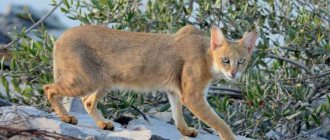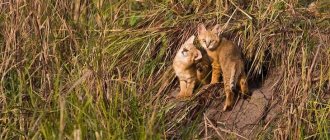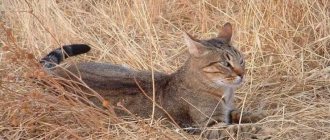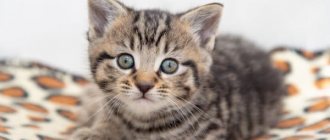Save the article:
If you are not familiar with the Nile cat - the same one that the Egyptians began to domesticate in ancient times, then it’s time to learn about it. Although the very first drawings and legends about such a predatory and graceful animal date back to Ancient Egypt, the jungle cat inhabited quite vast territories in different countries.
Why are we talking about such a magnificent animal as the reed or swamp lynx in the past tense, if it is an amazing hunter? It is precisely this quality that was not appreciated by those people whose jungle cat actively exterminated poultry. The durable and beautiful skin of the animal found its application in the economy - the process of extermination of the wonderful creature was launched, anthropogenic activity in nature also made its contribution. But did these colorful individuals remain in their natural habitat? It's time to learn about the jungle cat, also called the house cat (from the Latin Felis chaus), and its fate in our time.
Description of jungle cats
global $ads_google;
//data-ad-slot=”2475549904″ $ads_google = empty($ads_google) ? false : true; ?> if ($ads_google == false) {?> $ads_google = true; ?> } ?> Where today you can see ten subspecies of the predator in natural habitats, it is in Kashmir, the Caucasus (Caucasian reed cat), Indochina, South India, North India, Pakistan, the Nile River Valley in Egypt and on the island. Sri Lanka.
So, how can you recognize the “same” cat in a wild animal you meet?
Like the lynx, the jungle cat has small tufts at the tips of its ears. The color of the coat is very strongly influenced by the habitat: the main shades of the coat are brown, gray and brown with various combinations. Often a red stripe is visible along the spine. The ears, forehead and back of the head are also reddish, but the groin area and chin are whitish-yellowish. The gray tail has black rings and a tip. Newly born kittens will be completely tabby.
Companions from Central Asia and northern Africa are gray-yellow in color - nature made sure that the predator blends into the landscape. South Asian cats are tan. The first description of the Haus breed was made by the naturalist Johann Anton Güldenstedt in 1776: he saw a large, strong cat with rounded ears with tassels, like a lynx. The animal's muzzle is long, thin, and there are whitish markings near the eyes and dark spots near the nose. An interesting fact is that the tail of wild cats is much shorter than that of an ordinary domestic cat - a third of the length of the entire body and head.
Jungle cats live about 14 years.
Dimensions and weight of jungle cats
Even at a tender age, jungle kittens are quite large. They are born weighing about 136 g and grow continuously, adding 20-22 g per day.
Wild representatives of the species weigh from 12 to 16 kg, and domestic cats of the reed breed are much smaller: 6-12 kg, which is still larger than the size of the average adult cat. Females weigh less than males and appear less massive. The habitat also affects weight: cats living in western Israel weigh almost half as much as those living in India. Competition among individuals for the right to survive probably plays a role.
The length of these handsome cats reaches 100-120 cm, and their height at the withers is approximately 50-70 cm. Since the animal’s legs are long, strong and strong, if you put an ordinary pet side by side for comparison, the difference will be even more noticeable.
House character
The wild swamp lynx is a lover of fish, so love for water is in its blood - how else could a strong beauty be able to enjoy her favorite taste? At the same time, water cleanses the animal’s skin of dirt and odor.
Once you watch the animal for a little while, it will immediately become clear that this is an intelligent, inquisitive and completely tireless animal. Those who want to train their pet will really like the House - he is very easy to train, follows commands with interest and can get along with other four-legged neighbors.
It is unlikely that you will be bored with such a pet, but you should understand that this cat will never become completely domestic - wild nature is in his blood.
Lifestyle of the swamp lynx
Judging by the name, it becomes clear that the wild cat house is not a fan of trees. He climbs higher only in case of direct threat. In nature, the animal chooses the burrows of other animals as its home, since they themselves do not consider it necessary to “build” housing with their paws. The animal will happily rest on the stale, crushed reeds. But the cat does not live in one hole for a long time - it tends to change its place of residence.
The hunt begins at nightfall: here physical indicators come to the aid of the cat. The animal jumps well, hears and smells perfectly, and the ability to swim makes it much easier to try to get to prey.
Jungle cats prefer a solitary lifestyle; males are interested in females exclusively during the breeding season.
Nutrition
The food preferences of the Hausa are manifested among waterfowl and fish; it is no coincidence that it swims and dives well. It also easily catches small rodents, gophers, hares, and even small piglets.
It guards prey near a nest or trail, jumping high and deftly after it. Muddy or swampy areas do not frighten the hunter; dense wool protects from getting wet. The ability to wait and attack quickly always provides the animal with prey. In general, the house is not picky about food. He is full if he gets two mice or one rat in a day.
Domestic tamed cats should be fed lean meat, and do not forget about herbal and vitamin supplements.
Jungle cats in the food chain
Little is known about the role of the Hausa in the food chain. They themselves act as hunters and carriers of parasites, both in wildlife and at home.
What does the jungle cat eat?
To get food for itself, the animal can hunt not only at night, but also during the day. The cat sits in ambush for a long time, not betraying its presence in any way, and then suddenly some rodent or unwary bird finds itself in its claws and teeth.
The reed lynx eats both a hare and a reptile with equal pleasure, and does not disdain to catch and eat a domestic chicken or goose. When hunting birds, the animal sneaks for a long time among the thickets of reeds or reeds, and then, having determined by ear where the flock has settled, jumps out and deftly grabs the prey.
Enemies
The original enemies of the wild jungle cat were predators - leopards and wolves. But gradually, with the development of agriculture, humans also joined the list of enemies: he began to exterminate cats for their merciless hunting of poultry. There are no other serious threats to the seal population, but the ones listed above are quite enough to reduce the number.
global $ads_google; //data-ad-slot=”2475549904″ $ads_google = empty($ads_google) ? false : true; ?> if ($ads_google == false) {?>
$ads_google = true; ?> } ?>
Interesting Facts
- The jungle cat often bathes and likes to dive headlong. The animal does this to eliminate the unpleasant odor of its body, as it scares away potential victims during the hunt.
- The animal hunts at night. It first watches the prey, then quickly jumps towards it, grabs it and bites it.
- A representative of the feline can watch the victim for hours, sitting near his hole.
- Males are born much more often, their share in the brood is approximately 76%.
- The animal's fur is coarse and short. In the summer the cat sheds, and in the winter it is covered with thick fur.
- In captivity, males raise their cubs and take care of them.
- The jungle cat's pupils are elongated into vertical lines.
Reproduction of reed lynxes and caring for offspring
At the end of February and beginning of March, male jungle cats begin to make loud calls - it’s time to give birth to new kittens, so you need to attract a female. At this time, you should not try to take a closer look at the animal, as it becomes aggressive and can direct its rage at a person.
After 53-66 days of pregnancy, 2-5 blind cubs are born. The female prepares a den for them, insulating it with dry grass and her fur. Usually the lair is located in the most difficult places for enemies to reach. Males often remain with the newly formed family for some time.
A marsh kitten becomes independent at six months, but does not leave its mother for a long time.
According to statistics, males are born in greater numbers.
Health
Such a cat has excellent health and immunity, since its genes were selected by nature itself. They are completely free of any hereditary diseases that are typical for artificially bred, “refined” cat breeds.
There are no special problems when keeping an animal. But he needs ultraviolet light, and therefore it is recommended to walk such pets outside on a harness, as well as a balanced diet. The jungle cat requires the attention and affection of the owner and games.
If these simple rules are followed, the animal will delight its owners with many years of life. Typically, the life expectancy of a jungle cat is 13-18 years. Also read the article about how long cats live.
Habitat of jungle cats
I wonder where such a beautiful animal is found in nature, and whether it lives in Russia? You can still find such a miracle in the Volga delta region, as well as along the western coast of the Caspian Sea. Previously, the marsh cat was often found in the Astrakhan Nature Reserve, but for almost 30 years no traces of it have been found there - it’s not for nothing that the wild beauty is listed in the Red Book.
Today it is easiest to find the animal in its natural habitat in the Caucasian territories, the Caspian regions of Russia, and the thickets of the Amu Darya River. There are still many Hausa cats in Asian and African lands. They don’t really strive to meet a person, so not everyone will be lucky enough to see them. Where there is a chance to meet a swamp cat, it is inconvenient for a person to pass. These are thickets of reeds, damp forests full of thorny bushes. Favorite places include ponds overgrown with sedge, but these cats do not live in open spaces.
The reasons for the gradual decline in the number of marsh cats are not only humans, but also the cold season: any subspecies of this cat is vulnerable due to its loose and sparse fur coat. Snow cover and cold weather also harm the population of animals that love warmth so much. But in addition to hunting, people indirectly influence the number of these animals: by reducing the floodplain lands of reeds, which are actively burned and mowed down, water bodies are drained, forests are mowed - the swamp cat has less and less habitat.
Jungle cat at home
No matter how much you try to dissuade those who want to put a wild creature in their home, it will be of no use. It’s better to talk about how a domestic jungle cat .
Maintaining such an unbridled and active creation of a house will not bring pleasure to people who value their furnishings - everything that was in its place will be chewed, turned over or torn off. For home keeping, it is better to provide the animal with conditions close to natural, for example, organize an enclosure with a pond.
What does a domestic cat (reed cat) do in the house? He gallops as hard as he can around the rooms, rushes like the wind, jumps around the corner onto the owner’s feet, immediately rushing off and disappearing under the closet, as if in a secret lair. To prevent the animal from becoming the absolute master of the house, they begin to educate it from early childhood, simultaneously accustoming it to a scratching post and a tray. To satisfy the natural needs of hunting, you will need to treat the Hausa with live food.
Buy a jungle cat kitten
global $ads_google; //data-ad-slot=”2475549904″ $ads_google = empty($ads_google) ? false : true; ?> if ($ads_google == false) {?>
$ads_google = true; ?> } ?>
It is unlikely that anyone will be able to buy a marsh lynx in Russia, since there are no nurseries selling reed kittens here. Of course, you can find an advertisement on some website for the sale of a reed kitten, but is it really such, because you can buy an ordinary yard cat for a fabulous price.
If you have a wild desire to buy a Hausa, then you should not trust illegal sources that are not able to document either the purity of the breed or the state of health of the animal. In addition, when poachers offer an animal from the wild, and not one raised in a nursery in an enclosure, one should not even hope that the cat will become a pet.
The cost of a reed kitten will be no less than 3-8 thousand dollars, so a lower price should alert buyers.
What and how to feed
Dry food, even the best premium quality, will not please a jungle cat. His diet should consist of natural products: lean lean meat, plant foods, vitamin supplements necessary to maintain health, and unprocessed live food (with skin, blood, feathers).
Feeding your pet periodically should remind him of wild hunting in the field.
Hybrid breeds of jungle cats
Since it is difficult to purchase a true reed lynx for your home for many reasons, you can consider purchasing hybrids of a wild cat and an Abyssinian cat. As a result of crossing, kittens called Chausie or Houseie are obtained. Chausie F1 (first generation hybrid) will differ from subsequent generations in a cooler disposition.
The Hausi cat can be placed in an apartment and enjoy its exotic appearance and friendly character. The breed was officially recognized in 2003, and since then it has had many admirers. Thanks to our crossbreeding work, we have the opportunity to keep at home an animal that retains the appearance of a wild cat and the easy-going, good disposition of the Abyssinian.











